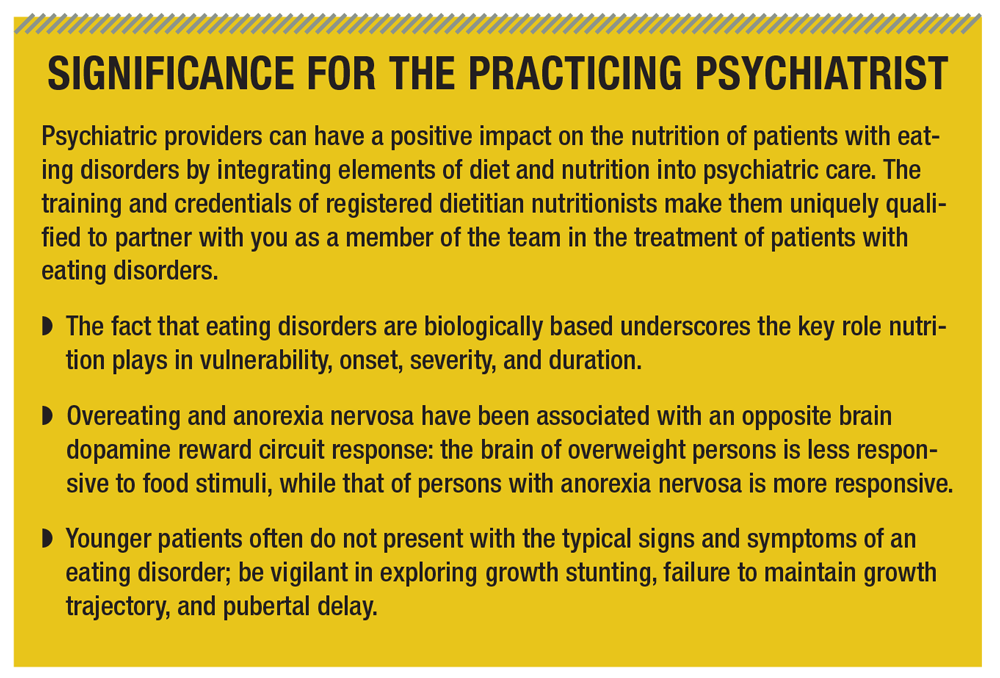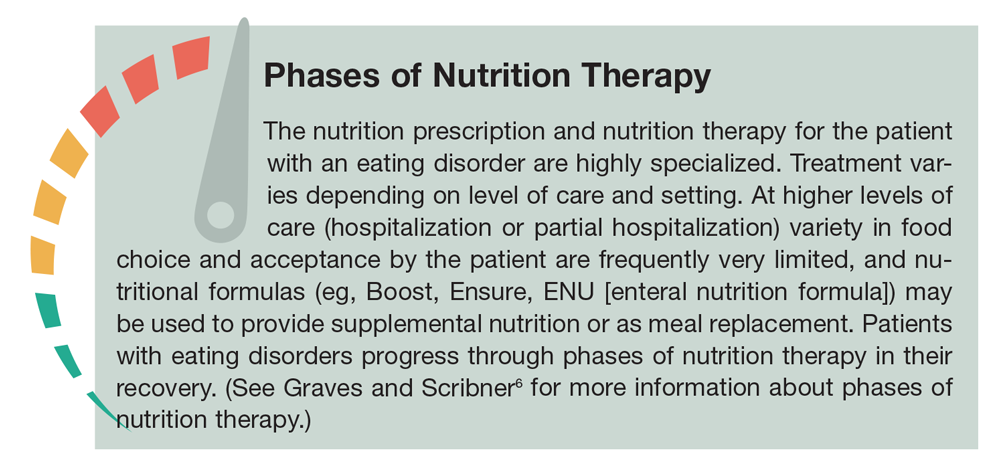Publication
Article
Psychiatric Times
Understanding Nutritional Needs of Patients With Eating Disorders: Implications for Psychiatrists
Author(s):
Eating disorders are second only to substance-abuse disorders in having the highest mental illness mortality rate. How do we assist the patient in moving forward?
Significance for the Practicing Psychiatrist

Phases of Nutrition Therapy

Figure. Major components of energy expenditure

Understanding the Role of a Registered Dietitian/Nutritionist. © Lightspring/shutterstock.com

TABLE. Nutrients of possible concern in eating disorders and mental health

Leave your drugs in the chemist’s pot if you can heal the patient with food.
-Hippocrates, 420 BC1
The etiology of disordered eating and eating disorders is not clear; in fact, there is much dissent among experts about their development and treatment. Yet, there is wide agreement that these disorders:
• Interfere with daily functioning (physical, psychological, and relational)
• Are a serious threat to life
• Are biologically based
Eating disorders include anorexia nervosa, bulimia nervosa, binge eating disorder, and avoidant restrictive food intake disorder. They are second only to substance-abuse disorders in having the highest mental illness mortality rate. While mortality associated with anorexia nervosa has long been recognized, more recently disorders previously categorized as “eating disorder not otherwise specified,” and now categorized as “other specified feeding or eating disorders,” are reported to be most prevalent and to have the highest mortality of any category of eating disorder.2,3
Changes to DSM-5 recognize that patients with eating disorders fall along the weight continuum, their weight fluctuates over the course of the illness, and females with anorexia nervosa may menstruate even while severely malnourished. It is important that we not put too much stock on appearance-even those who appear physically healthy and fit may be struggling with eating disorders.
Neuroscience, pharmacology, nutrition, and eating disorders
Nutrition is emerging as a major player in the high prevalence and incidence of mental disorders, with growing evidence to suggest that diet and nutrition are critical.4,5 A host of eating disorder complications, which affect multiple organ systems and compromise health, are related to nutrition. The fact that eating disorders are biologically based underscores the key role nutrition plays in vulnerability, onset, severity, and duration.
Malnutrition due to underconsumption of energy-producing macronutrients (carbohydrates, proteins, fats) and/or micronutrients relative to individual need is a concern with anorexia nervosa, bulimia nervosa, and avoidant restrictive food intake disorder. Moreover, eating disorder behaviors may affect the availability of micronutrients (vitamins and minerals).6 The result may be overt nutrient deficiencies (eg, anemias), chronic fatigue, reduced immune function, loss of lean body mass, and altered brain function. Patients may also be at risk for inflammatory diseases, such as cardiovascular disease, diabetes, and some cancers.4
Research on pharmacological treatment of eating disorders often yields mixed results and is particularly challenging because of the low number of study participants and high attrition rates.7 Body composition changes due to loss of lean tissue and/or increased adipose tissue may alter the body’s response to medication. Starvation, characterized by anorexia nervosa (and in some cases, avoidant restrictive food intake disorder), affects metabolism, neurotransmitters, and brain development. As in the case of thiamin, which influences appetite, poor nutrition resulting in clinically low nutrient levels may further affect nutritional intake.8 Eating disorder–related behaviors such as physical activity or purging may also affect the metabolism of medications.
Only 2 FDA-approved medications are available for treating eating disorders: fluoxetine for bulimia nervosa and lisdexamfetamine for binge eating disorder. It is no surprise then that patients with eating disorders and providers often turn to nutritional supplements in hopes of finding symptom relief.
The judicial use of nutritional supplements may be beneficial in treatment of mental health disorders such as eating disorders. For example, folate and S-adenosyl methionine (SAMe) are known for their role in the production of the neurotransmitters serotonin, norepinephrine, and dopamine. While increasing the intake of foods rich in folate may be helpful for some patients, many people, especially those with depression, may have a methylenetetrahydrofolate reductase (MTHFR) C677T polymorphism that limits conversion of folic acid/folate to L-methylfolate.9 The potential for nutritional treatment of mental illness is intriguing, yet the evidence is limited (Table).
Advanced technologies have added insight to our understanding of the role of nutrition in psychiatric illness, but it is still unclear how specific nutrients influence brain function. A look at the structure and function of the brain reveals circuits that regulate feeding/eating through reward, mood, fear, behavior control or flexibility, and body image.10 Alterations in brain structure may at least partially explain modified perceptions and behaviors among patients with eating disorders.11 Overweight due to overnutrition and anorexia nervosa have been associated with an opposite brain dopamine reward circuit response: the brain of overweight persons is less responsive to food stimuli, while that of persons who have anorexia nervosa is more responsive.12
According to Frank,10 dopamine alterations could be due to altered food intake or body weight. The apparently unstable dopamine circuits appear to sensitize with food restriction in anorexia nervosa, and desensitize with food excess (bulimia nervosa, binge eating disorder). Both bulimia nervosa and anorexia nervosa are associated with an increase in cognitive control, while binge eating disorder is associated with reduced cognitive control. Thus, the individual with anorexia nervosa finds relief (reward) in food restriction as overstimulation subsides. Similarly, in binge eating disorder, excess consumption of food is thought to further drive food intake as dopamine circuits become desensitized. Food restriction and purging in bulimia nervosa are driven cognitively, while binge eating may be driven by a hyposensitive dopamine response.
Energy needs in nutritional rehabilitation
The energy needs of a patient with an eating disorder are challenging to predict with accuracy. Energy needs may be complicated by acute or chronic starvation, physical activity, medication, and disease-related behaviors or comorbidity. No single formula exists for calculating resting metabolic rate among patients who have eating disorders. While indirect calorimetry is the most accurate method to measure resting metabolic rate, the benefits do not outweigh the risk of reinforcing the patient’s need to measure and monitor himself or herself.6 For the patient with anorexia nervosa, energy intake of 3000 to 4000 kcal may be required to achieve weight restoration, even when physical activity is restricted. The Figure shows the major components of energy expenditure.13
A variety of explanations have been offered to explain the difficulty of weight restoration with anorexia nervosa, including patient sabotage (hiding or discarding food), lying, or purging.6,13 In the early stages of feeding the semi-starved anorexia nervosa patient, the thermic effect of food may increase.13 Anxiety and depressive states related to fear of eating affect release of adrenocorticotropic hormone, cortisol, dopamine, and catecholamines.
Castellini and colleagues14 associated the severity of underweight in anorexia nervosa and the level of over-concern with body shape to corticotropin-releasing hormone and subsequently to cortisol levels. Cortisol, an anorexigenic catabolic marker that leads to mobilization of glucose, free fatty acids, and amino acids from endogenous stores during stress, subsequently decreases lean body mass, with increased energy expenditure. Thus, cortisol may be at least partially responsible for loss of desire to eat and difficulty of weight restoration.
Typically, assessment of energy intake relative to expenditure through monitoring weight, laboratory values, biological function (eg, reproduction, endocrine), and psychological function guides the nutrition prescription through the phases of recovery. Goal weight ranges consider family and personal history, growth and development, and medical and functional status.
A variety of methods are used in clinical practice to establish body weight goals, which are individualized and revised based on reassessment. Target weight ranges may reflect:
• An interim weight that supports stages of readiness to change
• Predicted weight to restore reproductive function
• A minimum to return to athletic participation
The Hamwi method or body mass index is frequently used to set goals for adults. Varying rates of growth and development among youth complicate setting goals. The methods for establishing target weight among youth include use of growth charts with height and weight trajectory.
Goal weight may be a moving target, particularly among growing youth and those who participate in sports. While it is beyond the scope of this paper to fully discuss the various methods used, it is important to recognize that while an RDN typically treats the patient to achieve target weight, setting the target requires time and involves consultation with the treatment team. When discussing weight goals with patients, it is often helpful to be somewhat vague, referring to getting “within your growth curve” or that “weight will take care of itself once eating and activity are normal and consistent.”
Although all patients should be assessed for eating disorder symptoms (eg, dieting/weight loss, recurrent vomiting, excessive exercise, body image distress or distortion), adolescents are at increased risk because of their developmental vulnerability. Younger patients often do not present with the typical signs and symptoms. Be vigilant in exploring growth stunting, failure to maintain growth trajectory, and pubertal delay. Similarly, those who are overweight or obese or who have chronic illness in which food or weight becomes a point of concern (eg, insulin-dependent diabetes) are also at risk for a missed diagnosis.
Conclusion
Coordination and collaboration of care may be difficult and simply seem unfeasible for a number of reasons (eg, patient loads, time constraints, lack of reimbursement), yet this is an essential component for improved patient outcomes. A multidisciplinary treatment team that engages in close collaboration, reinforces treatment approaches, and “speaks the same language” will promote a sense of trust and safety that will assist the patient in moving forward with change.
Brain research underscores the importance of the multidisciplinary team in the multifactorial origin of eating disorders, with altered brain function as a result of malnutrition (either over-nutrition or under-nutrition) playing important roles. Research in nutrition and mental health is advancing nutritional medicine-both dietary modification and specific nutrient prescriptions-forward as a mainstream element of psychiatric practice.15
While one would not disregard the importance of psychiatry or psychology in the treatment of eating disorders, it is imperative that we regard nutrition as a first line of defense and treatment. Thus, an RDN is an integral part of the treatment team.
Disclosures:
Ms Scribner teaches at Arizona State University, and she is the owner of Encompass Nutrition LLC, a private practice specializing in the treatment of eating disorders. She reports no conflicts of interest concerning the subject matter of this article.
References:
1. Marian MM, Mullin G, eds. Integrative Nutrition Therapy. New York: CRC Press; 2015.
2. National Association of Anorexia Nervosa and Related Disorders. http://www.anad.org/get-information/about-eating-disorders/eatingdisorders-not-otherwise-specified/. Accessed February 25, 2016.
3. Arcelus J, Mitchell AJ, Wales J, Nielsen S. Mortality rates in patients with anorexia nervosa and other eating disorders: a meta-analysis of 36 studies. Arch Gen Psychiatry. 2011;68:724-731.
4. Sarris J, Logan A, Akbaraly T, et al. Nutritional medicine as main-stream in psychiatry. Lancet Psychiatry. 2015;2:271-274.
5. Walker ER, McGee RE, Druss BG. Mortality in mental disorders and global disease burden implications: a systematic review and meta-analysis. JAMA Psychiatry. 2015;72:334-341.
6. Graves LL, Scribner C. Medical nutrition therapy for eating disorders. In: Smolak L, Levine MP, eds. The Wiley Handbook of Eating Disorders. Chichester, UK: John Wiley & Sons, Ltd; 2015.
7. Hay PJ, Claudino AM. Psychopharmacology in the treatment of eating disorders. In: Smolak L, Levine MP, eds. The Wiley Handbook of Eating Disorders. Chichester, UK: John Wiley & Sons, Ltd; 2015.
8. American Dietetic Association. Position of the American Dietetic Association: medical nutrition therapy and pharmacotherapy. J Am Diet Assoc. 1999;99:227-230.
9. Papakostas GI, Cassiello CF, Lovieno N. Folates and S-adenosylmethionine for major depressive disorder. Can J Psychiatry. 2012;57:406-413.
10. Frank GKW. The neurobiology of eating disorders: what causes eating disorders and what do they cause. Presented at: 31st Annual Sports, Cardiovascular, and Wellness Nutrition Symposium; April-May 2015; Colorado Springs, CO.
11. Frank GK, Shott ME, Hagman JO, Mittal VA. Taste reward circuitry related brain structures characterize ill and recovered anorexia nervosa and bulimia nervosa. Am J Psychiatry. 2013;170:1152-1160.
12. Frank GK, Reynolds JR, Shott ME, et al. Anorexia nervosa and obesity are associated with opposite brain reward response. Neuropsychopharmacol. 2012;37:2031-2046.
13. Rigaud D, Verges B, Colas-Linhart N, et al. Hormonal and psychological factors linked to the increased thermic effect of food in malnourished fasting anorexia nervosa. J Clin Endocrinol Metab. 2007;92:1623-1639.
14. Castellini G, Castellani W, Lelli L, et al. Association between resting energy expenditure, psychopathology and HPA-axis in eating disorders. World J Clin Cases. 2014;2:257-264.
15. Sarris J, Logan AC, Akbaraly TN, et al. International Society for Nutritional Psychiatry Research consensus position statement: nutritional medicine in modern psychiatry. World Psychiatry. 2015;14: 370-371.
16. Kleiman SC, Carroll IM, Tarantino LM, Bulik CM. Gut feelings: a role for the intestinal microbiota in anorexia nervosa. Int J Eat Disord. 2015;48:449-451.






